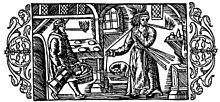Mole monkey
As mouth monkey or Gähnaffen head-shaped holder are clay since the Middle Ages, pine chips referred to, in their open mouth to put the kindling.
Since the 15th century is under Maulaffe (also in the 16th century monkey mouth ), "one who stands with open mouth and stares" meant a Gaffer - still used in the phrase "gaping hold".
Origin of the expression
The expression is probably based on mediaeval reality: When working in the dark, when you had to have both hands free, you wedged a burning pine between your teeth in order to have a little lighting. The early modern cartographer Olaus Magnus still illustrates and describes this in the middle of the 16th century:
“That is what you need through all the midnight countries of the Kienholtz in all sorts of forms / like the common house candles / Namely when one has to work with both hands / he puts a number of thinly cut chips / as much as he wants from under his belt, and nips up burning spon in the mouth / ... so goes to and against where he wants / ... and works what jm gefelt "
Usually, however, the pine chip was placed on a clay block. It was obvious to give such clay blocks the appearance of human faces and to clamp the chip in their mouth. There are finds of such clay chip holders from the 13th and 14th centuries, the name of such a holder is documented in reports from the beginning of the 20th century. In Austria these holders were called Geanmaul or Maulauf , in southern Germany yawning monkeys . From this the phrase "make someone yawn" was derived.
For the iron chisel holder used later, which were tong-shaped and adjustable in height, the name Maulaffe was retained, although nothing reminded of the original clay head.
The phrase “ hold the mole monkey for sale” was previously explained as a direct translation of the Low German “dat mul apen hollen” (“keep your mouth open”). This error goes back to Martin Luther's declaration "One who opens his mouth, whom we hold a mouth monkey in German". However, this is neither the second word hawk (sell) clarified, nor can be explained by the fact that in Low German, the phrases "Mulapen to kop hebben" ( "mouth monkey in the sale have") and "Mulapen verköpen" ( "mouth monkeys for sale") exist.
Similar expressions as with the mouth monkey can also be found for the names of other candlesticks, such as the candle holder, from which the female candlestick became or the oil idol , whose name comes from a holder for oil lamps .
Other meanings of the term "mouth monkey"
The expression “mole monkey” was - apart from the idiom - used historically in very different contexts; It is obvious to assume a common root in relation to the open mouth , but this has not yet been proven.
With the Aschaffenburger Maulaff , a wooden figure from the 18th century, there is a representation of a “gawker” that is very popular in the region up to the present day.
The last surviving city gate tower with gate system in Fladungen , the Obertorturm, is also known as the mouth monkey tower .
A wide-mouthed version of the Erlenmeyer flask was also as Maulaffe referred.
And finally, gable decorations with horse heads on farmhouses in Mecklenburg were called mulapen ( mouth monkeys ).
literature
- Rudolf EA Drey: Pharmacy jars. A History of Pharmaceutical Ceramics. Callwey, Munich 1980, ISBN 3-7667-0533-4 .
- Lutz Röhrich : Lexicon of proverbial sayings. Volume 3: Homer - Benefits. (= Herder spectrum; 4800), 4th edition. Freiburg im Breisgau u. a. 1999, ISBN 3-451-04800-0 , p. 1011 f.
- Mole monkey. In: Jacob Grimm , Wilhelm Grimm (Hrsg.): German dictionary . 16 volumes in 32 sub-volumes, 1854–1960. S. Hirzel, Leipzig ( woerterbuchnetz.de ).
- Mole monkey . In: Adelungs Grammatical-Critical Dictionary (since 1793 ff.)
Web links
- Brother fire. In the light of the morning: pine chips . State Office for Monument Preservation and Archeology Saxony-Anhalt
Remarks
Unless otherwise noted: All web links were last accessed on December 28, 2014.
- ↑ Book 2 (“Das Ander Buch”), Chapter 16, Basel 1567 (the German-language edition of the Historia de gentibus septentrionalibus ); Digitized version of the Bavarian State Library .
- ↑ cf. for the latter, the description by Martha Wolf. In: Viktoria Arnold (ed.): "When the light came". Memories of electrification . Böhlau, Vienna / Cologne / Weimar 2003, p. 35 f; Google digitized version .
- ^ The "Ascheberger Maulaff" on the website of the city of Aschaffenburg.
- ↑ Stadtarchiv Worms: Fladungen in der Rhön, view of the town with the city wall, Obertorturm (Maulaffenturm) and church in the German Digital Library
- ↑ cf. for example the handbook of working methods in inorganic chemistry , edited by Arthur Stähler et al., Veith & Co., Leipzig 1913, p. 99; see also Uwe Neddemeyer: Treasure Chest in the Eifeltal . ( Memento of the original from November 5, 2013 in the Internet Archive ; PDF; 2.6 MB) Info: The archive link was inserted automatically and has not yet been checked. Please check the original and archive link according to the instructions and then remove this notice. In: Rheinisches Zahnärzteblatt , vol. 48, issue 1, January 2005, p. 54.
- ↑ cf. Chr. Petersen: The horse heads on the farmhouses, especially in northern Germany . In: Yearbooks for regional studies of the duchies of Schleswig, Holstein and Lauenburg . Volume 3. Kiel 1860, p. 220 f., Google digitized version .



